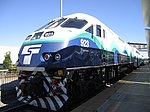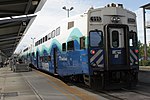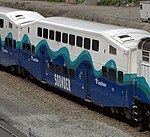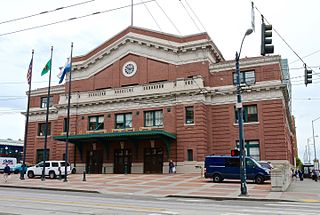
Sound Transit (ST), officially the Central Puget Sound Regional Transit Authority, is a public transit agency serving the Seattle metropolitan area in the U.S. state of Washington. It operates the Link light rail system in Seattle and Tacoma, regional Sounder commuter rail, and Sound Transit Express bus service. The agency also coordinates the regional ORCA fare card system, which is also used by local transit operators. In 2019, Sound Transit services carried a total of 48 million passengers and averaged over 161,000 riders on weekdays.

Community Transit (CT) is the public transit authority of Snohomish County, Washington, United States, excluding the city of Everett, in the Seattle metropolitan area. It operates local bus, paratransit and vanpool service within Snohomish County, as well as commuter buses to Downtown Seattle and Northgate station. CT is publicly funded, financed through sales taxes, and farebox revenue, with an operating budget of $133.2 million. In 2022, the system had a ridership of 5,788,700, or about 23,600 per weekday as of the second quarter of 2023, placing it fourth among transit agencies in the Puget Sound region. The city of Everett, which serves as the county seat, is served by Everett Transit, a municipal transit system.

The Amtrak Cascades is a passenger train corridor in the Pacific Northwest, operated by Amtrak in partnership with the U.S. states of Washington and Oregon. It is named after the Cascade mountain range that the route parallels. The 467-mile (752 km) corridor runs from Vancouver, British Columbia, through Seattle, Washington, and Portland, Oregon, to Eugene, Oregon.

Transportation in Seattle is largely focused on the automobile like many other cities in western North America; however, the city is just old enough for its layout to reflect the age when railways and trolleys predominated. These older modes of transportation were made for a relatively well-defined downtown area and strong neighborhoods at the end of several former streetcar lines, now mostly bus lines.

The 1 Line, formerly Central Link, is a light rail line in Seattle, Washington, United States, and part of Sound Transit's Link light rail system. It serves 19 stations in the cities of Seattle, SeaTac, and Tukwila, traveling nearly 25 miles (40 km) between Northgate and Angle Lake stations. The line connects the University District, Downtown Seattle, the Rainier Valley, and Seattle–Tacoma International Airport. The 1 Line carried over 25 million total passengers in 2019, with an average of nearly 80,000 daily passengers on weekdays. It runs for 20 hours per day on weekdays and Saturdays, with headways of up to six minutes during peak hours, and reduced 18-hour service on Sundays and holidays.

Everett Station is an Amtrak train station serving the city of Everett, Washington, United States. The station has provided service to the Cascades and Empire Builder routes since its opening in 2002, replacing an earlier station near the Port of Everett. The four-story building also houses social service programs and is the center of a 10-acre (4 ha) complex that includes parking lots and a large bus station used primarily by Community Transit, Everett Transit, and Sound Transit Express. The station has served as the northern terminus of the Sounder N Line since 2003 and the Swift Blue Line since 2009. It consists of two side platforms, one serving Amtrak and the other serving Sounder commuter trains. Everett Station also functions as a park and ride, with 1,067 short-term parking spaces located in lots around the station after it was expanded by Sound Transit in 2009.

Link light rail is a light rail rapid transit system serving the Seattle metropolitan area in the U.S. state of Washington. It is managed by Sound Transit in partnership with local transit providers, and consists of two non-connected lines: the 1 Line in King County, which travels for 26 miles (42 km) between Seattle and Seattle–Tacoma International Airport; and the T Line in Pierce County, which runs for 4 miles (6.4 km) between Downtown Tacoma and Tacoma Dome Station. In 2022, the system had a ridership of 23.9 million, or about 81,300 per weekday as of the second quarter of 2023, primarily on the 1 Line. Trains run at frequencies of 6 to 24 minutes.

The T Line, formerly known as Tacoma Link, is a light rail line in Tacoma, Washington, part of the Link light rail system operated by Sound Transit. It travels 4.0 miles (6.4 km) and serves 12 stations between Tacoma Dome Station, Downtown Tacoma, and Hilltop. The line carried 934,724 total passengers in 2019, with a weekday average of over 3,100 boardings. Tacoma Link runs for nine to 18 hours per day, using streetcars at frequencies of 12 to 20 minutes.

The Hartford Line is a commuter rail service between New Haven, Connecticut, and Springfield, Massachusetts, using the Amtrak-owned New Haven–Springfield Line. The project is a joint venture between the states of Connecticut and Massachusetts, with support from the federal government as well. CT Rail-branded trains provide service along the corridor, and riders can use Hartford Line tickets to travel on board most Amtrak trains along the corridor at the same prices. The service launched on June 16, 2018.
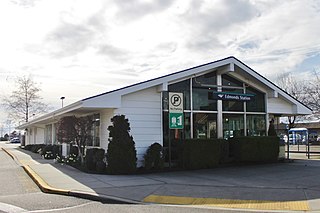
Edmonds station is a train station serving the city of Edmonds, Washington, in the United States. The station is served by Amtrak's Cascades and Empire Builder routes, as well as Sound Transit's N Line, a Sounder commuter rail service which runs between Everett and Seattle. It is located west of Downtown Edmonds adjacent to the city's ferry terminal, served by the Edmonds–Kingston ferry, and a Community Transit bus station. Edmonds station has a passenger waiting room and a single platform.

Mukilteo station is a train station serving the city of Mukilteo, Washington. It is owned by Sound Transit, who runs the N Line of the Sounder commuter rail service through the station from Everett to King Street Station in Seattle. The station includes a parking lot with 63 spaces, as well as connections to nearby Washington State Ferries, Community Transit, and Everett Transit service on State Route 525. Mukilteo station opened in 2008 with a single side platform, later supplemented with a second platform and pedestrian overpass in 2016.
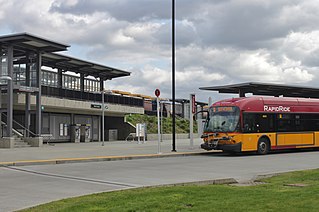
Tukwila station is a train station in Tukwila, Washington, United States. The station was built by Sound Transit to serve its Sounder commuter rail service on the S Line, as well as Amtrak's intercity Cascades line. It includes 390 parking spaces and a bus platform served by King County Metro's RapidRide F Line and other routes.

Auburn station is a train station in the city of Auburn, Washington, United States, served by S Line of the Sounder commuter rail network. It is located southwest of downtown Auburn and consists of two train platforms, a bus station, a parking garage, a public plaza, and a pedestrian bridge. The station has 633 parking spaces and is also served by Sound Transit Express, King County Metro, and Pierce Transit buses. Auburn station opened in 2000 and was built on the site of a former railroad station that was demolished in 1979. The parking garage and pedestrian bridge opened in 2003, and a second parking garage is planned to be built by 2027.

Puyallup station is a train station in the city of Puyallup, Washington, United States. It is served by the S Line, a Sounder commuter rail line operated by Sound Transit that runs from Pierce County to Seattle. The station is located northwest of downtown Puyallup and includes two platforms, several bus bays, and 640 parking spaces. Puyallup station opened on February 5, 2001, on the site of the city's original train depot, which was built in 1877 and demolished in 1974. The station's park and ride was expanded to 1,044 stalls in 2023 with the opening of a new parking garage. In addition to train service, the station is also served by Sound Transit Express and Pierce Transit buses that connect Puyallup to nearby cities.

Tacoma Dome Station is a train station and transit hub in Tacoma, Washington, United States. It is served by Amtrak trains, the S Line of Sounder commuter rail, the T Line of Link light rail, and buses on local and intercity routes. Located near the Tacoma Dome south of Downtown Tacoma, the station consists of two train platforms used by Sounder and Amtrak trains, a platform for the T Line, a bus terminal, and two parking garages. The Sounder station is integrated into Freighthouse Square, a former Milwaukee Road depot that was converted into a shopping mall, and is on the east side of the Amtrak station.

The Pacific Northwest Corridor or the Pacific Northwest Rail Corridor is one of eleven federally designated higher-speed rail corridors in the United States and Canada. The 466-mile (750 km) corridor extends from Eugene, Oregon, to Vancouver, British Columbia, via Portland, Oregon; and Seattle, Washington, in the Pacific Northwest region. It was designated a high-speed rail corridor on October 20, 1992, as the one of five high-speed corridors in the Intermodal Surface Transportation Efficiency Act of 1991 (ISTEA).

Lakewood station is a commuter rail station in Lakewood, Washington, United States. It is the terminus of the S Line of the Sounder commuter rail network, operated by Sound Transit in the Seattle metropolitan area. The station, located along Pacific Highway Southwest, includes a 620-stall parking garage and several bus bays served by Intercity Transit and Sound Transit Express. Lakewood station was originally scheduled to open in 2002 as part of a Sounder extension, but plans were delayed due to funding issues and the state government's work on the Point Defiance Bypass project. Construction on the $33 million station and garage began in March 2007 and it opened for use by buses on September 18, 2008. Sounder service to Lakewood began in October 2012 and the pedestrian bridge opened a few months later.

South Tacoma station is a commuter rail station in Tacoma, Washington, United States, served by the S Line of the Sounder commuter rail network. It is located near the Tacoma Mall along South Tacoma Way at South 56th Street and consists of a single platform and a 220-stall park-and-ride lot. Construction on the station began in early 2008 and the park-and-ride lot opened in February 2009, with service from a temporary express bus that operated until Sounder service began in October 2012.

The Point Defiance Bypass is a 14.5-mile-long (23.3 km) rail line between the cities of DuPont and Tacoma in Pierce County, Washington. It was originally built by the Northern Pacific Railway – the Tacoma–Lakewood segment in 1874 as part of the Prairie Line, and the Lakewood–DuPont section in 1891. Passenger service on the lines declined after the 1914 completion of a flatter route along Puget Sound, and ended entirely in 1956.



